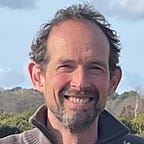Maximum freedom and maximum cohesion?
Like all practitioners in the field of organisations and organising, I am frequently confronted with the invisible, intangible nature of organisations. They can’t be seen or touched — to talk about them meaningfully, a tangential approach is required.
One such approach is metaphor. The metaphor I offer in this post is that of a motor car’s suspension.
If it wasn’t for its suspension, the modern car wouldn’t work. The passengers would feel each tiny bump in the road, and the sensitive workings of the car would be quickly shaken up and damaged. Yet for the car to do its job, the engine, seats and passengers need to be connected to the chassis, which is connected to the ground through the tyres. The suspension is our sophisticated solution to this. It keeps the passengers and the engine attached to the chassis, while being protected from all but the worst of the bumps. We are connected but not connected — a resolution to an apparent paradox.
In her book “The Quantum Society”, psychologist Danah Zohar points out the paradoxical nature of being human. Drawing on insights from quantum physics, she observes that when a person is too tightly attached to a particular viewpoint, person or group, they lose their individuality. On the other hand, if too detached they lose their ability to affect the system. A middle way, which Zohar calls a poised state, is a dynamic place from which the individual can draw on their individuality to influence the group. They are both individual and at the same time part of a larger whole. It is a paradox.
Modern organisations don’t tolerate paradox gladly. They prefer to demand obedience, holding us rather too tightly for their or our own good. The employment relationship, in effect, is a contract where we accept money and do what we are told. Unless we take great care, it robs us of our freedom. Likewise, our ownership structures seek to clasp the people in the organisation tightly to the owners’ purpose, exerting a gravitational pull that is rarely aligned with the deeper individual and collective purposes of the people. These conflicts are the cause of much stress and unhealthy behaviour.
“It is so nice not to be owned.”, observed an ex-banker to a friend of mine, having left his employer after 14 years of faithful service. My friend is an executive coach. She tells me that she doesn’t work with organisations; rather she helps people “recover from what happens to them in organisations”.
A familiar response to this predicament is to focus on individuals. If only they would exhibit more leadership, then everything would work out.
I agree with this… up to a point. But I suggest a more imaginative and long-term rewarding, whilst admittedly more challenging, approach is to re-design the hidden architecture of the organisations.
The goal it seems to me, is to design the organisational architecture for the people to be free (to be creative, purposeful, moral creatures) while at the same time feeling part of a bigger whole, sensing into what serves the collective needs and aspirations. I think of this as maximum freedom and maximum cohesion.
This feels like a radical re-writing of the genetic code of our organisations. Technically, I am sure it is possible — although admittedly it is a bigger challenge than designing the suspension for a car (there are far more moving parts!). There is an increasing diversity of organisations and movements promoting alternative approaches to ownership, governance, leadership, management, investment…
The real challenge is not a technical one, though. It is for enough of us to find the shared belief that our institutions are capable of such change (voluntarily or otherwise), that they can be re-made so they serve all of life, not a tiny sliver of it.
A hopeless task? Impossible odds? Maybe. Yet the story of human evolution tells how our ancestors found their way past even the most daunting of challenges. This is our great work. Who’s up for it?
